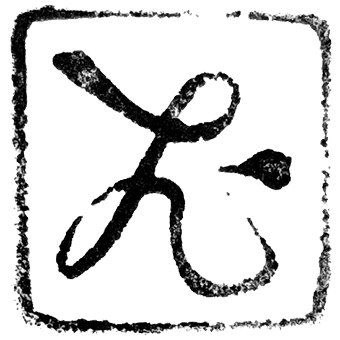INTERVIEW
Adélaïde de saint Mars: In the title of your work, to which beginning are you referring?
Hu Jiaxing & Zhao Fei: This creative project, entitled “In the beginning”, manifests the cosmogonic origin of the act of creation. As Goethe said: “In the beginning was the action (Am Anfang war die Tat)”. In this work, the cosmogonic act is threefold. Firstly, the volcanic eruption in the Geldingadalur Valley in Iceland since 19 March 2021 has been a cosmogonic event. When Icelanders are in nature and celebrate the earth in its cosmogonic action, they understand that this landscape is thus created, destroyed, and recreated. They, therefore, feel invited by Nature to attend this “feast” which consists of periodic but permanent participation in the “outpouring of primordial Time”. In this sense, the beginning is the beginning of the World, of Time. Then, the sounds of the gushing magma recorded and recomposed as a “heartbeat” of the Earth, will transform a natural cave in the forest of Saint-Germain-en-Laye into a cosmogonic field, beats coming from the interior of the earthly world make the cave noticeably alive. The graphic performance in the cave in a cosmogonic state refers to the act of creation of the Aurignacians on the walls in the Grotte Chauvet-Pont d’Arc, dating from about 37,000 to 33,500 B.C. These ancestors, creators of images and symbols, transformed the cave into a sacred space, into an energy field of communication between man and divinity. The work is also the beginning of Man, a being who can create images and symbols. And finally, this work is exhibited in the laboratory that Professor Edouard Branly (1844-1940), a researcher at the Institut Catholique de Paris in the 1875s, who in 1890 made the first wireless telegraphy transmission. He revealed, in this space heavily covered with copper, the invisible cosmic energy as a shattering means of communication. The meeting of images and sounds with this space of the telegraphic beginning pays tribute to Édouard Branly.
Emmanuel Lincot: We groped around, including in the choice of the title. “Kai tian pi di” (literally: the separation between earth and sky) from the ancient Chinese legends could have been its name and that would have given it a different meaning compared to the inaugural sentence of the Bible – “In the beginning was the Word” – which Goethe, as we know, would swap for “In the beginning was action”. The beginning is always the beginning of something else, and I see in Hu Jiaxing & Zhao Fei’s artistic gesture a succession of mutations that are those of an inventive process that combines thought with the intelligence of the hand. From all times, in all places, this gesture is reproduced in an infinity of actions… And Ariadne’s thread in the choice of this theme referring to the myths of the origins seems here to continue by the idea of a transmission which since the dawn of humanity, passing by the brilliant discovery of Branly, accompanies us with its sacred fire.
Adélaïde de saint Mars: What were the reasons that led you to collaborate?
Hu Jiaxing & Zhao Fei: This project is the result of several collaborations. Since the volcanic eruption in the Geldingadalur valley, we contacted the people who were able to travel to Iceland and film the event to convince them to allow us to use the recorded sounds; most of them did so happily. The sound installation initially made by Zhao Fei and the graphic performance by Hu Jiaxing complement each other. One was created from our Icelandic experience; the other in a cave in the forest of Saint Germain en Laye. This sound and visual ensemble was, in a third stage, projected and then put in abyme in the space of the Edouard Branly Museum of the Institut Catholique. The collaboration with Emmanuel Lincot, curator of this ephemeral exhibition, is as natural as it is logical. Indeed, we spoke with him a lot about our reflections on cave art during our stays in Pont d’Arc to visit the Aurignacian paintings on the walls of the Grotte Chauvet. Emmanuel Lincot also encouraged us to create projects where the marvelous is combined with scientific reflection. When he invited us to visit Édouard Branly’s laboratory at the ICP for inspiration, we were immediately struck by the quality of the space, which resembled a cave, or sacred space. That’s how this collaborative project was born.
Emmanuel Lincot: I had followed Hu Jiaxing’s remarkable thesis work, particularly on Chinese proto-writing. I also knew him as an artist, and the fact that we were joining forces with Zhao Fei, herself an artist and researcher, seemed natural to me. As you also know, our task is to highlight the history of the Catholic Institute, its great intellectual figures, and its places of memory. Now, not only have Hu Jiaxing and Zhao Fei just reminded us of the aesthetic and symbolic interest of Faraday’s cage, but two great figures of the Catholic Institute were versed in the study of paleontology and prehistory. I am referring to Teilhard de Chardin, discoverer of Peking Man and renowned theologian, and Abbé Breuil, discoverer of Lascaux, who was for many years in charge of the Carmelite seminary. This seminary is, let us remember, just opposite Edouard Branly’s studio. It is this intertwining of histories and languages that I felt it was important to reveal.
Adélaïde de saint Mars: Why did you choose film as your artistic medium?
Hu Jiaxing & Zhao Fei: This creation is quite complex because it is composed of both a sound installation and an image installation. Each sound and image was collected in nature, sprang from the bosom of the earth, and then captured by recording devices. The work consists of a successive transformation of space and time. The sound installation from the Geldingadalur valley meets the film installation from the cave in the forest of Saint Germain en Laye before undergoing final transformations in the space of the Musée Édouard Branly. The film is a medium that allows us to immerse ourselves in this world in an artistic relationship.
Emmanuel Lincot: Film allows for a simulacrum that also has ritual value here. One must imagine that the shadow of a hand or a projected silhouette, as Pliny the Elder reminds us, makes present what is absent. This relationship between visible and invisible has a strong religious dimension. And Edouard Branly is also one of the most august heirs of this long history.
Adélaïde de saint Mars: What were your choices regarding the symbolism of the place in which you exhibit?
Hu Jiaxing & Zhao Fei: The original idea of this artistic creation comes from the particular quality of the space of the Musée Édouard Branly. The copper covering of its interior totally deprives the sounds and images of the outside; on the other hand, this inner world gives an obvious feeling of earthly gravity, of an energy condensed before its eruption. The history of the place as a place of experimentation of the principle of radioconduction and telemechanics, still inspires us for its symbolism as a field of energetic exchanges.
Emmanuel Lincot: This Faraday cage is a deaf room. No interference can come from the outside. It is a particularly inspiring place for those who undertake a contemplative process or an inner reflection, and “In the beginning” is certainly one of them.
Adélaïde de saint Mars: What is the content of Franco-Chinese cooperation in the fields of palaeoanthropology and archaeology? Do you have any examples?
Hu Jiaxing & Zhao Fei: Franco-Chinese cooperation in the fields of palaeoanthropology and archaeology has been rich and important since the end of the 19th century. As early as 1870, Chinese students were sent to France and other Western countries to learn modern archaeological methods. This history of Franco-Chinese encounters between men of texts and men of the field is illustrated in particular by the sinologist Édouard Chavannes (1865-1918), translator of the Historical Memoirs of Sima Qian, who in 1908 continued his journey in the field with a precious inventory of funerary and Buddhist monuments whose inscriptions he translated. The encounter between France and China is also illustrated by the poet-archaeologist Victor Segalen, at the beginning of the 20th century, when he discovered in the great Chinese statuary a power that reminded him of the megaliths of his native Brittany. And let us quote Paul Pelliot who discovered manuscripts in the caves of Dunhuang. In 1916, the Geological Survey of China was created to train field researchers, brilliantly directed by the Chinese archaeologist Ding Wenjiang. It will allow the establishment of a fruitful collaboration with the best specialists between China and the West, including the Jesuit Father Teilhard de Chardin, a great palaeontologist and discoverer in the inter-war period of the Peking man in Zhoukoudian, which created a profound influence in China in palaeontology.
Emmanuel Lincot: In addition to these founding examples, this cooperation has recently continued in Xinjiang and Gansu, sensitive regions that are very rich in terms of heritage. The innovation would be to welcome teams of Chinese archaeologists in France, but we are still far from that.
Adélaïde de saint Mars: One of the pioneers of prehistory studies in France and former head of the Carmes convent at the Institut Catholique, Abbé Breuil (1877-1961), fought to obtain recognition for cave art. Are you in a contemporary mutation of the latter in order to make it more accessible?
Hu Jiaxing & Zhao Fei: Certainly. We are always fascinated by things from the distant past, whether they are myths and legends, or ancient traces that still exist. They are all, without exception, anchored in our present life. For example, the very large cave paintings left by prehistoric man are like a never-fading light in the depths of time. They invite us to enter the caves to explore the origins of the human mind. Abbé Breuil has made great efforts for the recognition of cave art, but the meaning of this prehistoric art is still unfamiliar to many of us. The images and symbols left on the walls of the caves remain mysterious. We wish to manifest its cosmic aspect through this creative project.
Emmanuel Lincot: The discovery of Lascaux by Abbé Breuil was a shock for his contemporaries. It was in 1940 at a time when France was collapsing. Many years later, great writers such as Georges Bataille devoted magnificent pages to these cave paintings and thus played a large part in their “invention” in the eyes of public opinion. Making the public aware of this art from the earliest times of humanity allows us to reconnect with a creative gesture that is always being repeated. The fact that Hu Jiaxing and Zhao Fei, two Chinese and French-speaking artists, are successfully doing this is particularly touching.
Adélaïde de saint Mars: In your opinion, what does cave art tell us about Man?
Hu Jiaxing & Zhao Fei: Through the images of cave art, we often see that man and his surrounding environment – the animal or plant world – are spiritually transformed. Originally, man is not the center of the world, his respect, not without ignorance or fear, for nature, is in fact a precious quality that allows him to live peacefully in this world. From an anthropological point of view, man can be defined as a being who knows how to create images and symbols. Cave art has greatly expanded our horizons on the cultural history of our humanity. When we are confronted today with major problems in art, society, and ecology, when we think about the fate of mankind, we may as well go back tens of thousands of years and see how our ancestors showed their understanding of the world and of themselves through their art. This journey through space and time can give us some inspiration.
Emmanuel Lincot: Art in its questioning is not alien to the philosophical problems we are asking ourselves today. It is the sensitive extension of theorizations to which a Baptiste Morizot or a Philippe Descola confront their analyses, whether in the relationship between nature and culture, the language of animals and the language of humans… “In the beginning” participates in this, with humility of course, but by reminding us that our identity has been constructed in a relationship that constantly oscillates between ruptures and continuity. Victor Segalen had a very beautiful definition of the Chinese he lived with, more than a century ago, when he described them as “continuous men”. In short, we are all continuous men and the work of Hu Jiaxing & Zhao Fei reminds us of this with great conviction.
Adélaïde de saint Mars: Finally, what cliché would you like to deconstruct about prehistory?
Hu Jiaxing & Zhao Fei: André Leroi-Gourhan, the famous French archaeologist and anthropologist, wrote that prehistory is a very vague term, which refers to everything that has elapsed since the appearance of the first standing being until the invention of writing, which allows man to order his thoughts. But until the 20th century, Indians in the Amazonian forests were still inventing their writing. To call art created before the invention of writing “prehistoric art”, or art simplified to differentiate it from the usual form of art “primitive art”, is not very accurate. For example, when one is confronted with the first images and symbols of the Aurignacians, one quickly realizes that it is superficial and crude to label subtle techniques, deep creative motifs, and concepts developed by these prehistoric artists as “primitive”. When we see Australian Aborigines repeating the same graphic gesture on images created by their ancestors, we find it difficult to define whether it is prehistoric or modern painting. These spiritual images and symbolic acts of creation reveal to us not only an extraordinary conception of art, but also an incredible continuity of primordial Time.
Emmanuel Lincot: It is not so much prehistory and its image that is deconstructed here as our relationship to art, time and death. Of course, Europe and its tradition, in the very writing of history – its own and that of non-European peoples – has been conceived, at least since Thucydides, according to causal hierarchies and then, in the history of art, according to stylistic approaches that anthropology has long since questioned. Primitivism” or “primitive” art are two examples among many others. However, this hierarchization distorts our view and gives it an ideological and value-based judgment that is hardly operative and is sometimes even dangerous. I think that from a heuristic point of view, the notions of “survival” (nachleben as Aby Warburg called it) and “circulation” allow us to decentralize our gaze and thus rehabilitate unsuspected trajectories that we are keen to rediscover.
_
Thanks to Siggi Anton and Jakob Vegerfors who have generously granted permission to use the sound material recorded in the Geldingadalur Valley in Iceland.
ICP Acknowledgments: Virginie Grand, Isabella Salburg, Audrey Marguritat, Mustapha Athemani
Communication ICP : https://www.icp.fr/a-propos-de-licp/actualites/lart-sinvite-a-licp-hu-jiaxing-zhao-fei
[1] Goethe, Le Faust, traduction en français par Henri Blaze, Dutertre, 1847. p. 119






